Oracle面试题及答案整理
- 格式:docx
- 大小:25.97 KB
- 文档页数:22

oracle数据库面试题2023很高兴您关注数据库面试题,以下是一些常见的Oracle 数据库面试题及其答案:1. 什么是Oracle数据库?Oracle数据库是由Oracle公司开发的一种关系型数据库管理系统(RDBMS),它是目前世界上最流行的商用数据库之一。
Oracle数据库提供了数据存储、管理和操作等功能,被广泛应用于企业级应用系统。
2. 请解释Oracle数据库的架构。
Oracle数据库的架构由三个主要组件组成:实例(Instance)、内存结构和物理存储。
实例是指Oracle数据库在内存中的运行进程,负责管理和控制数据库的访问和操作。
内存结构包括SGA(System Global Area)和PGA(Program Global Area),用于存储数据库和用户进程所需的数据和信息。
物理存储则指数据库文件和表空间,用于持久化地存储数据。
3. 什么是表空间(Tablespace)?表空间是Oracle数据库中用于存储表、索引、视图等数据库对象的逻辑容器。
每个表空间由一个或多个数据文件组成,这些文件可以分布在不同的物理存储介质上。
通过使用表空间,我们可以方便地管理数据库对象的存储和分配。
4. 请解释Oracle的归档模式(Archivelog Mode)和非归档模式(Noarchivelog Mode)的区别。
在归档模式下,Oracle数据库会将所有的重做日志文件(Redo Log)保存下来,以便进行数据恢复和备份。
这种模式适用于对数据完整性和可恢复性要求较高的场景。
而非归档模式下,Oracle数据库不会保存重做日志文件,只保留最新的重做日志。
这种模式适用于对数据恢复要求较低、但对性能要求较高的场景。
5. 如何查看Oracle数据库中的当前用户?在Oracle数据库中,可以通过以下SQL语句查看当前用户:```SELECT USER FROM DUAL;```这会返回当前会话的用户名。
6. 如何备份和恢复Oracle数据库?Oracle数据库的备份和恢复可以使用多种方法,其中常用的有物理备份和逻辑备份。
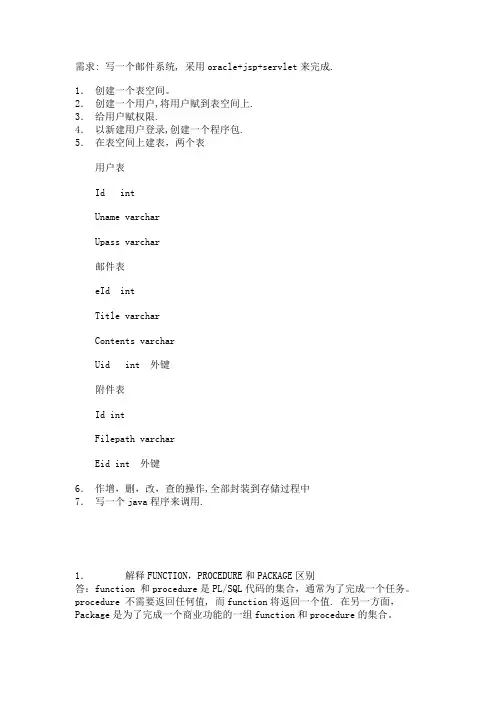
需求: 写一个邮件系统, 采用oracle+jsp+servlet来完成.1.创建一个表空间。
2.创建一个用户,将用户赋到表空间上.3.给用户赋权限.4.以新建用户登录,创建一个程序包.5.在表空间上建表,两个表用户表Id intUname varcharUpass varchar邮件表eId intTitle varcharContents varcharUid int 外键附件表Id intFilepath varcharEid int 外键6.作增,删,改,查的操作,全部封装到存储过程中7.写一个java程序来调用.1.解释FUNCTION,PROCEDURE和PACKAGE区别答:function 和procedure是PL/SQL代码的集合,通常为了完成一个任务。
procedure 不需要返回任何值, 而function将返回一个值. 在另一方面,Package是为了完成一个商业功能的一组function和procedure的集合。
2.取某个序列的当前值的PL/SQL语句怎么写?答:SELECT 序列名.CURRVAL FROM DUAL;Create sequence 名字 start with x increment by y maxvalue z nocycle3.说明ORACLE数据库实例与ORACLE用户的关系?答:实例可以包含多个用户,一个用户只能在一个实例下4.创建用户时,需要赋予新用户什么权限才能使它连上数据库?答:grant CONNECT [on 表名] to 用户名5.比较truncate和delete命令?答:两者都可以用来删除表中所有的记录。
区别在于:truncate是DDL(data defining language数据定义语言),它移动HWK,不需要rollback segment(处理事务回滚操作)而Delete是DML(data manufacturing language数据操作语言)操作,需要rollback segment(处理事务回滚操作)且花费较长时间6.给出数据的相关约束类型?答:主键约束,外键约束,非空约束,唯一约束,检查约束。
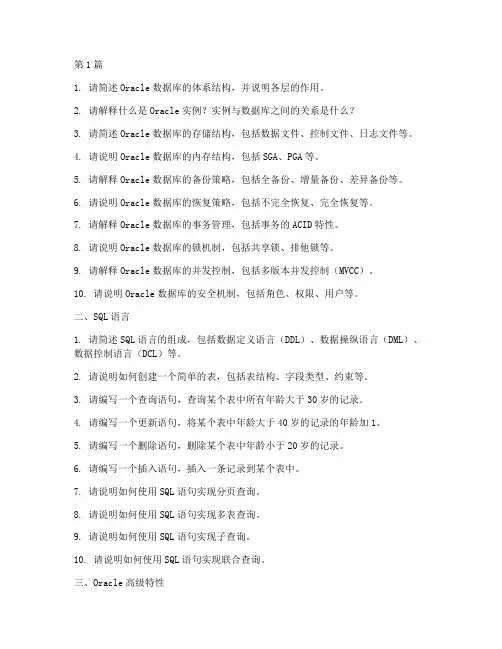
第1篇1. 请简述Oracle数据库的体系结构,并说明各层的作用。
2. 请解释什么是Oracle实例?实例与数据库之间的关系是什么?3. 请简述Oracle数据库的存储结构,包括数据文件、控制文件、日志文件等。
4. 请说明Oracle数据库的内存结构,包括SGA、PGA等。
5. 请解释Oracle数据库的备份策略,包括全备份、增量备份、差异备份等。
6. 请说明Oracle数据库的恢复策略,包括不完全恢复、完全恢复等。
7. 请解释Oracle数据库的事务管理,包括事务的ACID特性。
8. 请说明Oracle数据库的锁机制,包括共享锁、排他锁等。
9. 请解释Oracle数据库的并发控制,包括多版本并发控制(MVCC)。
10. 请说明Oracle数据库的安全机制,包括角色、权限、用户等。
二、SQL语言1. 请简述SQL语言的组成,包括数据定义语言(DDL)、数据操纵语言(DML)、数据控制语言(DCL)等。
2. 请说明如何创建一个简单的表,包括表结构、字段类型、约束等。
3. 请编写一个查询语句,查询某个表中所有年龄大于30岁的记录。
4. 请编写一个更新语句,将某个表中年龄大于40岁的记录的年龄加1。
5. 请编写一个删除语句,删除某个表中年龄小于20岁的记录。
6. 请编写一个插入语句,插入一条记录到某个表中。
7. 请说明如何使用SQL语句实现分页查询。
8. 请说明如何使用SQL语句实现多表查询。
9. 请说明如何使用SQL语句实现子查询。
10. 请说明如何使用SQL语句实现联合查询。
三、Oracle高级特性1. 请解释什么是视图?如何创建视图?2. 请解释什么是索引?有哪些常见的索引类型?3. 请解释什么是触发器?如何创建触发器?4. 请解释什么是存储过程?如何创建存储过程?5. 请解释什么是函数?如何创建函数?6. 请解释什么是包?如何创建包?7. 请解释什么是序列?如何创建序列?8. 请解释什么是同义词?如何创建同义词?9. 请解释什么是物化视图?如何创建物化视图?10. 请解释什么是分区表?如何创建分区表?四、Oracle性能优化1. 请说明如何查看Oracle数据库的性能统计信息。
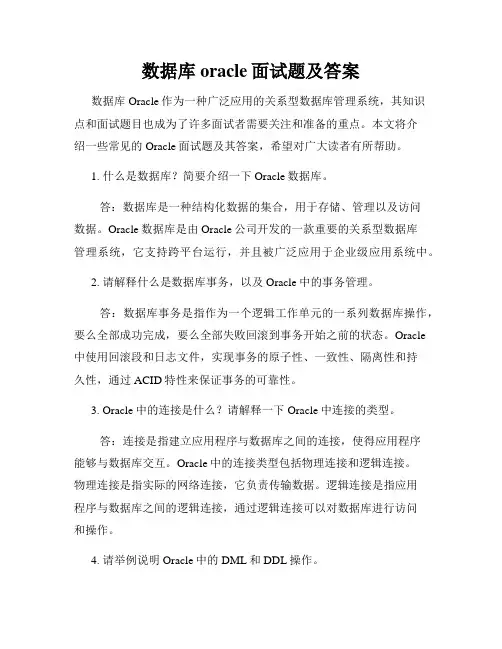
数据库oracle面试题及答案数据库Oracle作为一种广泛应用的关系型数据库管理系统,其知识点和面试题目也成为了许多面试者需要关注和准备的重点。
本文将介绍一些常见的Oracle面试题及其答案,希望对广大读者有所帮助。
1. 什么是数据库?简要介绍一下Oracle数据库。
答:数据库是一种结构化数据的集合,用于存储、管理以及访问数据。
Oracle数据库是由Oracle公司开发的一款重要的关系型数据库管理系统,它支持跨平台运行,并且被广泛应用于企业级应用系统中。
2. 请解释什么是数据库事务,以及Oracle中的事务管理。
答:数据库事务是指作为一个逻辑工作单元的一系列数据库操作,要么全部成功完成,要么全部失败回滚到事务开始之前的状态。
Oracle中使用回滚段和日志文件,实现事务的原子性、一致性、隔离性和持久性,通过ACID特性来保证事务的可靠性。
3. Oracle中的连接是什么?请解释一下Oracle中连接的类型。
答:连接是指建立应用程序与数据库之间的连接,使得应用程序能够与数据库交互。
Oracle中的连接类型包括物理连接和逻辑连接。
物理连接是指实际的网络连接,它负责传输数据。
逻辑连接是指应用程序与数据库之间的逻辑连接,通过逻辑连接可以对数据库进行访问和操作。
4. 请举例说明Oracle中的DML和DDL操作。
答:DML操作(数据操纵语言)用于对数据库中的数据进行增删改查,比如INSERT、UPDATE和DELETE语句。
例如,可以使用INSERT语句向表中插入新的记录;使用UPDATE语句修改已有记录;使用DELETE语句删除指定的记录。
DDL操作(数据定义语言)用于定义数据库对象,例如创建表、修改表结构等。
例如,可以使用CREATE TABLE语句创建新的表;使用ALTER TABLE语句修改表结构。
5. 请解释Oracle中的索引是什么以及索引的作用。
答:索引是一种数据结构,用于提高数据库查询的效率。
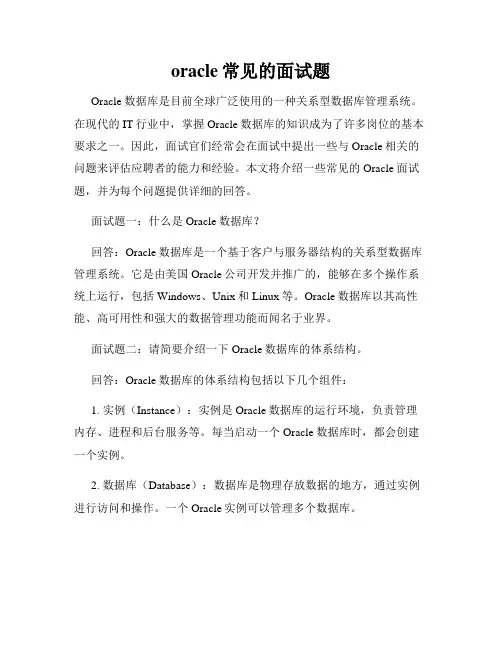
oracle常见的面试题Oracle数据库是目前全球广泛使用的一种关系型数据库管理系统。
在现代的IT行业中,掌握Oracle数据库的知识成为了许多岗位的基本要求之一。
因此,面试官们经常会在面试中提出一些与Oracle相关的问题来评估应聘者的能力和经验。
本文将介绍一些常见的Oracle面试题,并为每个问题提供详细的回答。
面试题一:什么是Oracle数据库?回答:Oracle数据库是一个基于客户与服务器结构的关系型数据库管理系统。
它是由美国Oracle公司开发并推广的,能够在多个操作系统上运行,包括Windows、Unix和Linux等。
Oracle数据库以其高性能、高可用性和强大的数据管理功能而闻名于业界。
面试题二:请简要介绍一下Oracle数据库的体系结构。
回答:Oracle数据库的体系结构包括以下几个组件:1. 实例(Instance):实例是Oracle数据库的运行环境,负责管理内存、进程和后台服务等。
每当启动一个Oracle数据库时,都会创建一个实例。
2. 数据库(Database):数据库是物理存放数据的地方,通过实例进行访问和操作。
一个Oracle实例可以管理多个数据库。
3. 数据文件(Data File):数据文件是数据库中存储数据的文件,每个文件对应一个表空间(Tablespace)。
Oracle数据库使用数据文件来存储表、索引、触发器等对象的数据。
4. 表空间(Tablespace):表空间是逻辑存储单元,用于管理和组织数据库中的对象。
每个表空间由一个或多个数据文件组成。
5. 表(Table):表是数据库中用于存储数据的基本对象,由多个列(Column)组成。
面试题三:请介绍一下Oracle数据库的事务(Transaction)概念。
回答:在Oracle数据库中,事务是一系列数据库操作的逻辑单元,它要么全部执行成功,要么全部回滚。
事务可以保证数据库的一致性和完整性。
事务具有以下四个特性,常简称为ACID特性:1. 原子性(Atomicity):事务作为一个整体执行,要么全部成功,要么全部失败。
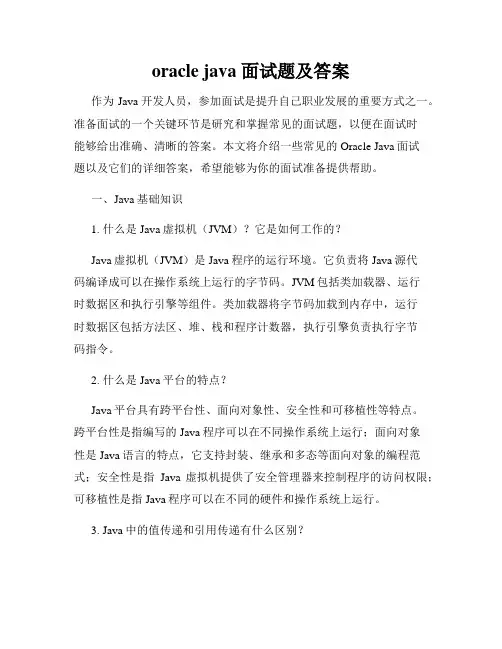
oracle java 面试题及答案作为Java开发人员,参加面试是提升自己职业发展的重要方式之一。
准备面试的一个关键环节是研究和掌握常见的面试题,以便在面试时能够给出准确、清晰的答案。
本文将介绍一些常见的Oracle Java面试题以及它们的详细答案,希望能够为你的面试准备提供帮助。
一、Java基础知识1. 什么是Java虚拟机(JVM)?它是如何工作的?Java虚拟机(JVM)是Java程序的运行环境。
它负责将Java源代码编译成可以在操作系统上运行的字节码。
JVM包括类加载器、运行时数据区和执行引擎等组件。
类加载器将字节码加载到内存中,运行时数据区包括方法区、堆、栈和程序计数器,执行引擎负责执行字节码指令。
2. 什么是Java平台的特点?Java平台具有跨平台性、面向对象性、安全性和可移植性等特点。
跨平台性是指编写的Java程序可以在不同操作系统上运行;面向对象性是Java语言的特点,它支持封装、继承和多态等面向对象的编程范式;安全性是指Java虚拟机提供了安全管理器来控制程序的访问权限;可移植性是指Java程序可以在不同的硬件和操作系统上运行。
3. Java中的值传递和引用传递有什么区别?Java中的基本类型是值传递,而对象类型是引用传递。
值传递是指将变量的值复制一份传递给方法或函数,而引用传递是指将变量的引用(内存地址)传递给方法或函数。
在值传递中,形参的改变不会对实参产生影响,而在引用传递中,形参改变会影响到实参。
4. 什么是Java的自动装箱和拆箱?Java的自动装箱和拆箱是指基本类型和对应的包装类型之间的自动转换。
自动装箱是将基本类型自动转换为对应的包装类型,而拆箱是将包装类型自动转换为对应的基本类型。
例如,int类型的变量可以自动装箱为Integer对象,Integer对象可以拆箱为int类型。
5. 什么是Java的四种访问修饰符?Java的四种访问修饰符分别是public、private、protected和default (没有修饰符)。
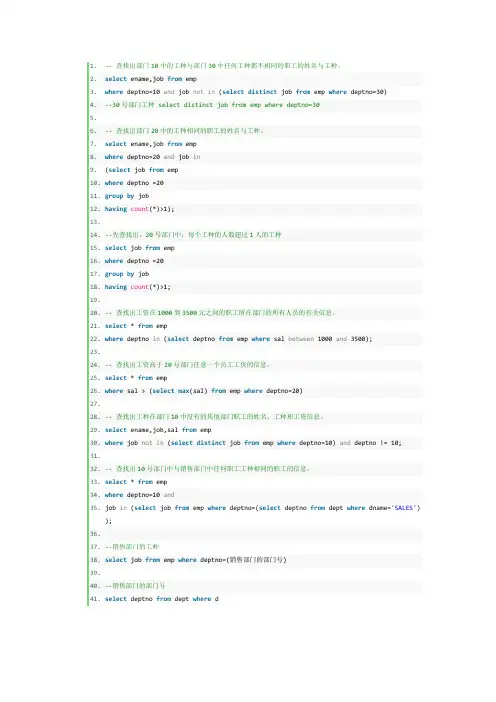
1.-- 查找出部门10中的工种与部门30中任何工种都不相同的职工的姓名与工种。
2.select ename,job from emp3.where deptno=10 and job not in (select distinct job from emp where deptno=30)4.--30号部门工种 select distinct job from emp where deptno=305.6.-- 查找出部门20中的工种相同的职工的姓名与工种。
7.select ename,job from emp8.where deptno=20 and job in9.(select job from emp10.where deptno =2011.group by job12.having count(*)>1);13.14.--先查找出,20号部门中,每个工种的人数超过1人的工种15.select job from emp16.where deptno =2017.group by job18.having count(*)>1;19.20.-- 查找出工资在1000到3500元之间的职工所在部门的所有人员的有关信息。
21.select * from emp22.where deptno in (select deptno from emp where sal between 1000 and 3500);23.24.-- 查找出工资高于20号部门任意一个员工工资的信息。
25.select * from emp26.where sal > (select max(sal) from emp where deptno=20)27.28.-- 查找出工种在部门10中没有的其他部门职工的姓名、工种和工资信息。
29.select ename,job,sal from emp30.where job not in (select distinct job from emp where deptno=10) and deptno != 10;31.32.-- 查找出10号部门中与销售部门中任何职工工种相同的职工的信息。
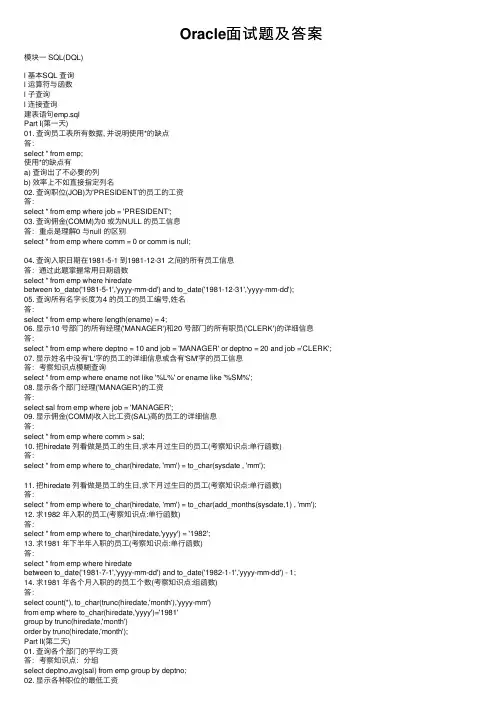
Oracle⾯试题及答案模块⼀ SQL(DQL)l 基本SQL 查询l 运算符与函数l ⼦查询l 连接查询建表语句emp.sqlPart I(第⼀天)01. 查询员⼯表所有数据, 并说明使⽤*的缺点答:select * from emp;使⽤*的缺点有a) 查询出了不必要的列b) 效率上不如直接指定列名02. 查询职位(JOB)为'PRESIDENT'的员⼯的⼯资答:select * from emp where job = 'PRESIDENT';03. 查询佣⾦(COMM)为0 或为NULL 的员⼯信息答:重点是理解0 与null 的区别select * from emp where comm = 0 or comm is null;04. 查询⼊职⽇期在1981-5-1 到1981-12-31 之间的所有员⼯信息答:通过此题掌握常⽤⽇期函数select * from emp where hiredatebetween to_date('1981-5-1','yyyy-mm-dd') and to_date('1981-12-31','yyyy-mm-dd');05. 查询所有名字长度为4 的员⼯的员⼯编号,姓名答:select * from emp where length(ename) = 4;06. 显⽰10 号部门的所有经理('MANAGER')和20 号部门的所有职员('CLERK')的详细信息答:select * from emp where deptno = 10 and job = 'MANAGER' or deptno = 20 and job ='CLERK';07. 显⽰姓名中没有'L'字的员⼯的详细信息或含有'SM'字的员⼯信息答:考察知识点模糊查询select * from emp where ename not like '%L%' or ename like '%SM%';08. 显⽰各个部门经理('MANAGER')的⼯资答:select sal from emp where job = 'MANAGER';09. 显⽰佣⾦(COMM)收⼊⽐⼯资(SAL)⾼的员⼯的详细信息答:select * from emp where comm > sal;10. 把hiredate 列看做是员⼯的⽣⽇,求本⽉过⽣⽇的员⼯(考察知识点:单⾏函数)答:select * from emp where to_char(hiredate, 'mm') = to_char(sysdate , 'mm');11. 把hiredate 列看做是员⼯的⽣⽇,求下⽉过⽣⽇的员⼯(考察知识点:单⾏函数)答:select * from emp where to_char(hiredate, 'mm') = to_char(add_months(sysdate,1) , 'mm'); 12. 求1982 年⼊职的员⼯(考察知识点:单⾏函数)答:select * from emp where to_char(hiredate,'yyyy') = '1982';13. 求1981 年下半年⼊职的员⼯(考察知识点:单⾏函数)答:select * from emp where hiredatebetween to_date('1981-7-1','yyyy-mm-dd') and to_date('1982-1-1','yyyy-mm-dd') - 1;14. 求1981 年各个⽉⼊职的的员⼯个数(考察知识点:组函数)答:select count(*), to_char(trunc(hiredate,'month'),'yyyy-mm')from emp where to_char(hiredate,'yyyy')='1981'group by trunc(hiredate,'month')order by trunc(hiredate,'month');Part II(第⼆天)01. 查询各个部门的平均⼯资答:考察知识点:分组select deptno,avg(sal) from emp group by deptno;02. 显⽰各种职位的最低⼯资答:考察知识点:分组select job,min(sal) from emp group by job;03. 按照⼊职⽇期由新到旧排列员⼯信息答:考察知识点:排序select * from emp order by hiredate desc;04. 查询员⼯的基本信息,附加其上级的姓名答:考察知识点:⾃连接select e.*, e2.ename from emp e, emp e2 where e.mgr = e2.empno;05. 显⽰⼯资⽐'ALLEN'⾼的所有员⼯的姓名和⼯资答:考察知识点:⼦查询select * from emp where sal > (select sal from emp where ename='ALLEN');分析:当查询结果是⼀⾏⼀列时,可以将此结果看做⼀个值,参与条件⽐较。
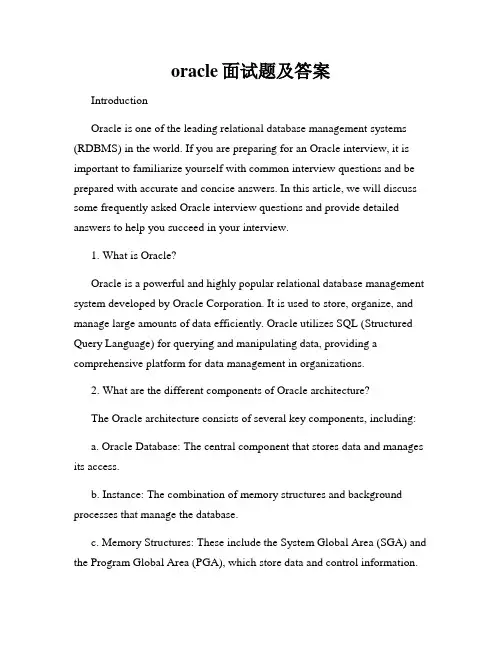
oracle面试题及答案IntroductionOracle is one of the leading relational database management systems (RDBMS) in the world. If you are preparing for an Oracle interview, it is important to familiarize yourself with common interview questions and be prepared with accurate and concise answers. In this article, we will discuss some frequently asked Oracle interview questions and provide detailed answers to help you succeed in your interview.1. What is Oracle?Oracle is a powerful and highly popular relational database management system developed by Oracle Corporation. It is used to store, organize, and manage large amounts of data efficiently. Oracle utilizes SQL (Structured Query Language) for querying and manipulating data, providing a comprehensive platform for data management in organizations.2. What are the different components of Oracle architecture?The Oracle architecture consists of several key components, including:a. Oracle Database: The central component that stores data and manages its access.b. Instance: The combination of memory structures and background processes that manage the database.c. Memory Structures: These include the System Global Area (SGA) and the Program Global Area (PGA), which store data and control information.d. Background Processes: These processes handle tasks such as managing memory, ensuring data integrity, and handling user connections.e. Physical Files: These files store the actual data, control files, redo logs, and archived logs.3. Explain the difference between a database and an instance in Oracle.In Oracle, a database refers to the collection of physical files that store data, control information, and other components. An instance, on the other hand, is the combination of memory structures and background processes that manage the database. In simple terms, a database is the stored data, while an instance is the software that operates on the data.4. What is the purpose of the control file in Oracle?The control file is a crucial component of an Oracle database. It contains metadata about the database, such as the database name, the names and locations of data files and redo logs, and the time of the last backup. The control file is used during database startup to verify the structure of the database and maintain consistency.5. How can you kill an Oracle session?To terminate an Oracle session, you can use the following SQL statement:```sqlALTER SYSTEM KILL SESSION '[sid],[serial#]';```Replace `[sid]` with the session ID and `[serial#]` with the serial number of the session you want to terminate. It is important to exercise caution when terminating sessions to avoid data corruption or loss.6. What are the different types of indexes in Oracle?Oracle supports various types of indexes to enhance query performance. Some commonly used index types include:a. B-Tree Index: The most common index type in Oracle, used for equality and range searches.b. Bitmap Index: Efficient for columns with a small number of distinct values.c. Function-Based Index: Created on an expression or function of one or more columns.d. Partitioned Index: Divides the index into smaller, more manageable pieces.e. Cluster Index: Organizes table rows that share common values in one or more columns.7. Explain the difference between COMMIT and ROLLBACK statements.In Oracle, the COMMIT statement is used to permanently save changes made within a transaction. It terminates the current transaction and makes all changes made up to that point visible to other users. On the other hand, the ROLLBACK statement is used to undo changes made within a transaction,reverting the database to its state before the transaction began. ROLLBACK can be issued either voluntarily or in response to an error or exception.8. How does Oracle handle concurrent access to the database?Oracle employs a mechanism called Multi-Version Concurrency Control (MVCC) to handle concurrent access to the database. MVCC allows multiple users to access and modify data simultaneously by providing each user with a snapshot of the data as it existed at the start of their transaction. This ensures data integrity and consistency while avoiding conflicts among concurrent transactions.ConclusionPreparing for an Oracle interview requires a solid understanding of the fundamental concepts and features of Oracle database management. By familiarizing yourself with common interview questions and practicing your answers, you can confidently demonstrate your knowledge and increase your chances of success. Remember to stay calm, organized, and concise in your responses, highlighting your expertise in Oracle and your ability to tackle various challenges in the database management field. Good luck!。
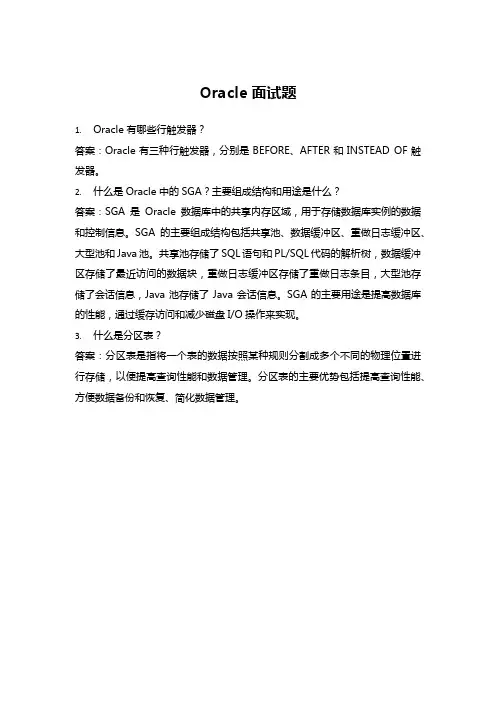
Oracle面试题
1.Oracle有哪些行触发器?
答案:Oracle有三种行触发器,分别是BEFORE、AFTER和INSTEAD OF触发器。
2.什么是Oracle中的SGA?主要组成结构和用途是什么?
答案:SGA是Oracle数据库中的共享内存区域,用于存储数据库实例的数据和控制信息。
SGA的主要组成结构包括共享池、数据缓冲区、重做日志缓冲区、大型池和Java池。
共享池存储了SQL语句和PL/SQL代码的解析树,数据缓冲区存储了最近访问的数据块,重做日志缓冲区存储了重做日志条目,大型池存储了会话信息,Java池存储了Java会话信息。
SGA的主要用途是提高数据库的性能,通过缓存访问和减少磁盘I/O操作来实现。
3.什么是分区表?
答案:分区表是指将一个表的数据按照某种规则分割成多个不同的物理位置进行存储,以便提高查询性能和数据管理。
分区表的主要优势包括提高查询性能、方便数据备份和恢复、简化数据管理。
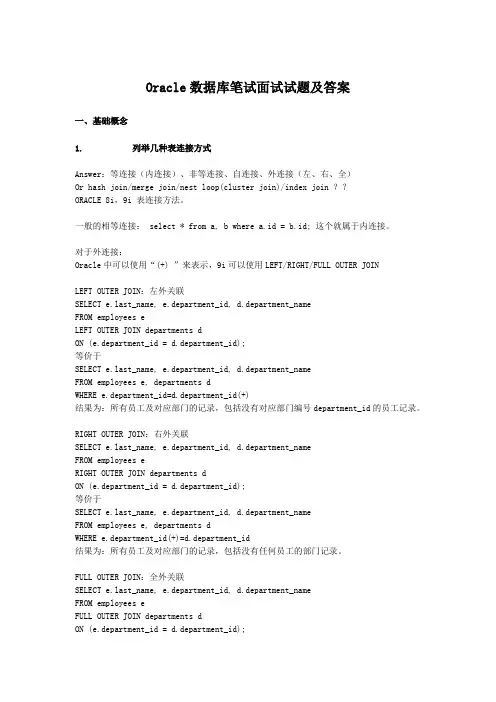
Oracle数据库笔试面试试题及答案一、基础概念1. 列举几种表连接方式Answer:等连接(内连接)、非等连接、自连接、外连接(左、右、全)Or hash join/merge join/nest loop(cluster join)/index join ??ORACLE 8i,9i 表连接方法。
一般的相等连接: select * from a, b where a.id = b.id; 这个就属于内连接。
对于外连接:Oracle中可以使用“(+) ”来表示,9i可以使用LEFT/RIGHT/FULL OUTER JOINLEFT OUTER JOIN:左外关联SELECT st_name, e.department_id, d.department_nameFROM employees eLEFT OUTER JOIN departments dON (e.department_id = d.department_id);等价于SELECT st_name, e.department_id, d.department_nameFROM employees e, departments dWHERE e.department_id=d.department_id(+)结果为:所有员工及对应部门的记录,包括没有对应部门编号department_id的员工记录。
RIGHT OUTER JOIN:右外关联SELECT st_name, e.department_id, d.department_nameFROM employees eRIGHT OUTER JOIN departments dON (e.department_id = d.department_id);等价于SELECT st_name, e.department_id, d.department_nameFROM employees e, departments dWHERE e.department_id(+)=d.department_id结果为:所有员工及对应部门的记录,包括没有任何员工的部门记录。
Oracle 试题一、选择题1.当你执行以下查询语句:SELECT empno,enameFROM empWHERE empno =7782 OR empno =7876;在WHERE语句中,以下哪个操作符可以取代OR?A.INB.BETWEEN ……C.LIKED.<=E.>=Answer: A2.哪个实现 IF..THEN…ELSE 逻辑?A.INITCAP()B.REPLACE()C.DECODE()D.IFELSE()Answer: C3.以下哪行有错?1 SELECT deptno2 FROM emp3 GROUP BY deptno4 HAVING COUNT(deptno)=5 (SELECT max(count(deptno))6 FROM emp7 GROUP BY deptno);A.Line 3B.Line 4C.Line 5D.Line 7E.都没错.Answer: E4.当一个程序执行了 SELECT...FOR UPDATE 语句, 以下哪个步骤必须需要完成?A.执行 COMMIT or ROLLBACK 结束 transaction, 即使并没有数据改变。
B.如果有数据改变 ,则需要执行commit or rollback 来结束 transaction。
C.由于只有数据确实改变后,一个transaction 才会开始,所以现在不需要COMMIT or ROLLBACK被执行。
Answer: A5.以下哪个命令可以被用来从表 STATE中 drop 列 UPDATE_DT ?A.ALTER TABLE STATE DROP COLUMN UPDATE_DT;B.ALTER TABLE STATE REMOVE COLUMN UPDATE_DT;C.DROP COLUMN UPDATE_DT FROM STATE;D.你不能从这个表中DROP该列.Answer: A6.哪个命令用来创建一个primary key constraintpk_books 在表 BOOKS, 列 ISBN上? 请选择一个。
oracle面试题及答案oracle面试题及答案(一)1、关系数据库系统与文件数据库系统的区别在那里?关系数据库系统一般适用那些方面? 答案:关系数据库系统文件系统的区别在于:首先,关系性数据库的整体数据是结构化的,采用关系数据模型来描述,这是它与文件系统的根本区别。
(数据模型包括:数据结构,数据操作以及完整性约束条件)其次,关系数据库系统的共享性高,冗余低可以面向整个系统,而文件系统则具有应用范围的局限性,不易扩展。
第三,关系数据库系统采用两级映射机制保证了数据的高独立性,从而使得程序的编写和数据都存在很高的独立性。
这方面是文件系统无法达到的,它只能针对于某一个具体的应用。
(两级映射:保证逻辑独立性的外模式/模式映射和保证物理独立性的内模式/模式映射。
外模式:用户模式,是数据库用户的局部数据的逻辑结构特征的描述。
模式:数据库全体数据的逻辑结构特征的描述。
内模式:也就是数据最终的物理存储结构的描述。
)第四,就是关系性数据库系统由统一的DBMS进行管理,从而为数据提供了如安全性保护,并发控制,完整性检查和数据库恢复服务。
2、触发器的概念,存储过程的概念.答案:触发器:是存储在数据库中的过程,当表被修改(增、删、改)时它隐式地被激发。
存储过程:是数据库语言SQL的集合,同样也存储在数据库中,但是他是由其他应用程序来启动运行或者也可以直接运行。
3、基本SQL语句有哪些.答案:select、insert、update、delete、create、drop、truncate4、使用存储过程访问数据库比直接用SQL语句访问有哪些优点?答案:存储过程是预编译过的,执行时勿须编译,执行速度更快;存储过程封装了一批SQL语句,便于维护数据的完整性与一致性;可以实现代码的复用。
oracle面试题及答案(二)1.解释冷备份和热备份的不同点以及各自的优点解答:热备份针对归档模式的数据库,在数据库仍旧处于工作状态时进行备份。
1.解说冷备份和热备份的不一样点以及各自的优点解答:热备份针对归档模式的数据库,在数据库依旧处于工作状态时进行备份。
而冷备份指在数据库封闭后,进行备份,合用于全部模式的数据库。
热备份的优点在于当备份时,数据库依旧能够被使用而且能够将数据库恢复到随意一个时间点。
冷备份的优点在于它的备份和恢复操作相当简单,而且因为冷备份的数据库能够工作在非归档模式下 ,数据库性能会比归档模式稍好。
(因为不用将 archive log 写入硬盘)2.你一定利用备份恢复数据库,可是你没有控制文件,该如何解决问题呢?解答:重修控制文件,用带backup control file 子句的 recover 命令恢复数据库。
3.如何变换 init.ora 到 spfile?解答:使用create spfile from pfile命令.4. 解说 data block , extent 和 segment 的差异(这里建议用英文术语)解答: data block 是数据库中最小的逻辑储存单元。
当数据库的对象需要更多的物理储存空间时,连续的 data block 就构成了 extent . 一个数据库对象拥有的全部extents 被称为该对象的 segment.5.给出两个检查表结构的方法解答: 1、DESCRIBE 命令2、包6. 如何查察数据库引擎的报错解答:alert log.7. 比较truncate 和delete 命令解答:二者都能够用来删除表中全部的记录。
不需要rollback segment . 而 Delete 是 DML差异在于: truncate 是 DDL操作 , 需要 rollback segment操作,它挪动 HWK且花销较长时间.,8. 使用索引的原由解答:迅速接见表中的data block9.给出在 STAR SCHEMA 中的两种表及它们分别含有的数据解答: Fact tables 和 dimension tables. fact table 包括大批的主要的信息而寄存对 fact table 某些属性描绘的dimension tables信息10. FACT Table 上需要成立何种索引?解答:位图索引(bitmap index )11. 给出两种有关拘束?解答:主键和外键12.如安在不影响子表的前提下,重修一个母表解答:子表的外键强迫无效,重修母表,激活外键13.解说归档和非归档模式之间的不一样和它们各自的优弊端解答:归档模式是指你能够备份全部的数据库档模式则相反,不可以恢复到随意一个时间点。
oracle数据库的面试题及答案1. 介绍一下Oracle数据库的特点和优势。
Oracle数据库是一种可扩展、可靠、高性能的关系数据库管理系统(RDBMS)。
其特点和优势包括:- 可扩展性:Oracle数据库可以轻松处理大规模数据和用户,并支持横向和纵向扩展。
- 可靠性:具备强大的恢复和容错能力,包括闪回技术、自动故障检测和修复等。
- 高性能:通过优化索引、查询优化器、高效的并发控制和内存管理等功能,提供卓越的性能。
- 安全性:提供多层次的安全性控制,包括用户认证、授权、加密和审计等。
- 支持多种数据类型:支持结构化和非结构化数据以及多媒体数据类型。
- 强大的开发工具支持:包括SQL Developer、PL/SQL开发工具等。
2. 请解释Oracle实例和数据库之间的关系。
Oracle实例是在服务器上运行的Oracle数据库的一个副本。
每个实例由内存结构和后台进程组成,用于管理和处理数据库的数据和操作。
而数据库是存储数据的物理文件集合。
一个服务器可以运行多个实例,但只能有一个数据库。
实例通过访问数据库文件来完成对数据的读写操作。
3. 请解释Oracle中的逻辑结构和物理结构。
逻辑结构是指以逻辑方式组织和访问数据的方式,包括表、索引、视图等。
物理结构则是指数据在磁盘上的存储方式,例如数据文件、控制文件和日志文件等。
4. 请解释Oracle中的事务和事务的四个特性。
事务是指数据库操作的逻辑单元,可以由一个或多个SQL语句组成。
事务具有以下四个特性(通常被称为ACID属性):- 原子性(Atomicity):事务被视为一个不可分割的操作单元,要么全部执行成功,要么全部回滚到初始状态。
- 一致性(Consistency):事务执行的结果必须使数据库从一个一致状态转换到另一个一致状态,不会破坏数据完整性。
- 隔离性(Isolation):每个事务在执行过程中都应该与其他事务隔离,即事务之间不能互相干扰。
oracle的面试题及答案在Oracle的面试过程中,面试官往往会提出一系列与Oracle数据库相关的问题。
为了帮助你准备面试,本文将介绍一些常见的Oracle面试题及其答案。
以下是一些常见的Oracle面试题及答案供你参考:1. Oracle数据库的基本概念是什么?Oracle数据库是一个基于关系模型的数据库管理系统,它的特点包括数据安全、高可用性、高性能和可扩展性。
2. 什么是Oracle实例和数据库?Oracle实例是Oracle数据库运行时的一个进程,它负责管理和访问数据库的所有资源。
数据库则是存储数据的物理文件集合。
3. 请解释什么是表空间(tablespace)?表空间是逻辑存储结构,它由一个或多个数据文件组成,用于存储数据库中的表、索引和其他对象。
4. Oracle中的数据类型有哪些?Oracle提供了多种数据类型,包括字符型、数值型、日期型、二进制型等。
5. 如何创建表?可以使用CREATE TABLE语句来创建表。
例如,CREATE TABLE employees (id NUMBER, name VARCHAR2(50), age NUMBER);6. 如何在Oracle中插入数据?可以使用INSERT INTO语句来向表中插入数据。
例如,INSERT INTO employees (id, name, age) VALUES (1, 'John', 25);7. 如何更新表中的数据?可以使用UPDATE语句来更新表中的数据。
例如,UPDATE employees SET age = 26 WHERE id = 1;8. 如何删除表中的数据?可以使用DELETE语句来删除表中的数据。
例如,DELETE FROM employees WHERE id = 1;9. Oracle中的索引有哪些类型?Oracle提供了多种索引类型,包括B树索引、位图索引、散列索引等。
oracle面试题及答案Oracle是目前世界上最大的企业级数据库管理系统之一,因其稳定性和可靠性而备受业界认可。
面试中,掌握Oracle相关知识是应聘者的一项重要技能。
本文将为大家提供一些常见的Oracle面试题及答案,帮助读者更好地准备面试。
1. 什么是Oracle数据库?Oracle数据库是一种关系型数据库管理系统,由美国Oracle公司开发。
它是一种高效、可靠的数据库系统,广泛应用于企业级的数据管理和处理领域。
2. Oracle数据库的特点有哪些?- 高度可靠:Oracle数据库具有强大的容错能力,具备数据备份、恢复和故障转移等功能。
- 高性能:Oracle数据库采用多种优化技术,能够高效地处理大量数据。
- 可扩展性强:Oracle数据库支持在线扩展和动态添加硬件资源,满足不断增长的需求。
- 数据安全性高:Oracle数据库提供许多安全功能,如用户身份验证、访问控制和数据加密等。
- SQL支持全面:Oracle数据库完全支持SQL语言,为用户提供了更多的操作和管理选项。
3. Oracle数据库的架构是怎样的?Oracle数据库的架构由多个重要组件组成,包括:- 实例(instance):负责和操作系统进行交互,管理数据库的运行和服务。
- 数据库(database):由多个数据文件组成,存储实际的数据。
- 内存结构(memory structure):包括共享池(shared pool)、数据字典缓冲区(dictionary cache)和重做(log buffer)等,提供性能优化和缓存管理。
- 后台进程(background processes):负责管理数据库实例和提供系统服务。
4. Oracle数据库中的事务是什么?事务是数据库操作的基本单位,是一系列对数据库的读写操作的执行序列。
事务要么全部执行成功,要么全部执行失败,具有一致性和原子性的特点。
5. Oracle数据库如何进行数据备份和恢复?Oracle数据库提供多种备份和恢复手段,包括物理备份和逻辑备份。
Oracle面试题及答案整理
Oracle面试题及答案整理
1、表:table1(FId,Fclass,Fscore),用最高效最简单的SQL列出各班成绩最高的列表,显示班级,成绩两个字段。
select fclass,max(fscore) from table1 group by fclass,fid
2、有一个表table1有两个字段FID,Fno,字都非空,写一个SQL语句列出该表中一个FID对应多个不同的Fno的纪录。
类如:
101a1001
101a1001
102a1002
102a1003
103a1004
104a1005
104a1006
105a1007
105a1007
105a1007
结果:
102a1002
102a1003
104a1005
104a1006
select t2.* from table1 t1, table1 t2 where t1.fid = t2.fid and t1.fno <> t2.fno;
3、有员工表empinfo
(
Fempno varchar2(10) not null pk,
Fempname varchar2(20) not null,
Fage number not null,
Fsalary number not null
);
假如数据量很大约1000万条;写一个你认为最高效的SQL,用一个SQL计算以下四种人:
fsalary>9999 and fage > 35
fsalary>9999 and fage < 35
fsalary <9999 and fage > 35
fsalary <9999 and fage < 35
每种员工的数量;
select sum(case when fsalary > 9999 and fage > 35 then 1
else 0end) as "fsalary>9999_fage>35",
sum(case when fsalary > 9999 and fage < 35
then 1
else 0
end) as "fsalary>9999_fage<35",
sum(case when fsalary < 9999 and fage > 35
then 1
else 0
end) as "fsalary<9999_fage>35",
sum(case when fsalary < 9999 and fage < 35
then 1
else 0
end) as "fsalary<9999_fage<35"
from empinfo;
4、表A字段如下
month person income
月份人员收入
要求用一个SQL语句(注意是一个)的处所有人(不区分人员)每个月及上月和下月的总收入
要求列表输出为
月份当月收入上月收入下月收入
MONTHS PERSON INCOME
---------- ---------- ---------- 07 mantisXF 5000 06
mantisXF2 3500 06 mantisXF3 3000 05 mantisXF1
05 mantisXF6 2 00804 mantisXF7 1800 03 8mantisXF 4000 02 9mantisXF 4 00802 10mantisXF 3300 01
11mantisXF 4600 09 11mantisXF 6800
11 rows selected
select months, max(incomes), max(prev_months), max(next_months)
from (select months,
incomes,
decode(lag(months) over(order by months),
to_char(add_months(to_date(months, 'yyyymm'), -1), 'yyyymm'), lag(incomes) over(order by months), 0) as prev_months, decode(lead(months) over(order by months), to_char(add_months(to_date(months,
'yyyymm'), 1), 'yyyymm'), lead(incomes) over(order by months), 0) as next_months from (select months, sum(income) as incomes from a group by months) aa) aaagroup by months;
MONTHS MAX(INCOMES) MAX(PREV_MONTHS)
MAX(NEXT_MONTHS)---------- ------------ ---------------- ---------------- 01 4600 0 7500 02 7500 4600 4000。